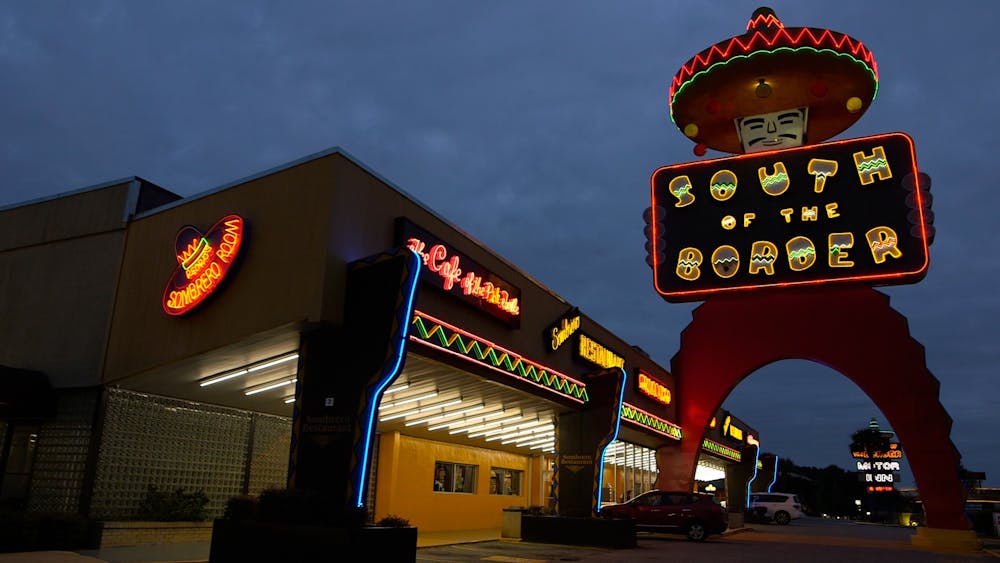South of the Border opened as a beer depot in 1949. It has since expanded to include a motel, amusement park, "sombrero tower" and more.
The park’s founder, Alan Schafer, was a Jewish Southerner. He registered African Americans to vote as early as the 1940s and campaigned for supporters of civil rights legislation such as Lyndon B. Johnson.
However, in 1961, the Civil War Centennial, Schafer opened “Confederateland, USA,” containing Pedro’s Plantation — where tourists picked cotton. Schafer has been accused of co-opting the Black vote, and he served time in federal prison after a vote-buying scandal in 1980.
Rubén Ortiz-Torres, an artist and professor at University of California-San Diego, featured South of the Border in his 1995 film, "Frontierland," which examined American perceptions of Mexico and vice versa. He said these are often filled with mistranslations and misunderstandings that produce a strange, distorted version of reality.
“I ended up spending a week there, by myself, in what I really, honestly felt like the Twilight Zone of a Mexican immigrant in the U.S.,” Ortiz-Torres said.
Cecilia Márquez, assistant professor of history at Duke University, wrote “Becoming Pedro: ‘Playing Mexican’ at South of the Border.”
“What I found particularly interesting about the site was the way that it took pre-existing ideas about Latinos elsewhere in the country and made that work for Southern needs,” she said.
Torres said he feels like a Southerner first and a Mexican American second. South of the Border visually embodies what it means to be Mexican in the South, he said.
Araceli Cruz, a Mexican American reporter who described her 2017 visit to South of the Border in an article for "mitú," said it was difficult for her as a new resident of North Carolina to be near a place that made fun of her culture.
“When it’s someone of your own community having a Mexican restaurant and portraying Latin figures and characters, it’s not as bad because it’s someone from your own community highlighting wonderful aspects to their culture,” she said. “But when it’s a white person doing that, or a non-Latino person doing that, they don’t have the right to do that.”
Ryan Schafer, Alan Schafer’s grandson and South of the Border’s owner, said the site has not received pushback from its theme and has a growing Latino clientele.
“The authentic Mexican stuff sells really well, and the Spanish people that do come through seem to appreciate being able to find the stuff from Mexico,” he said.
To get the day's news and headlines in your inbox each morning, sign up for our email newsletters.
Villarosa said watching Latinx people take photos with the “Pedro” statue at South of the Border prompted her to further explore Latinx people’s reactions to the site.
Márquez said “Pedro” is damaging to Latinx people arriving in Southern communities.
“Those images, coupled with the anti-immigrant legislation throughout the Southeast and throughout the country, can make the South at times a really hard place to be Latino,” she said.
Ortiz-Torres said he understands and lives with the problems of the image of Pedro, but thinks South of the Border is so outrageous that it is unclear what Pedro represents.
“Sometimes we give too much power to the image,” he said. “I don’t think the images are what caused the problems. The problems are already there.”
Present and future
Schafer said due to the political climate in recent years, there has been a reemergence of overt racism in his community.
“I can remember as a kid the Klan burning crosses in our yard,” he said. “I don’t know if it was because we were Jewish or because we hired African Americans, I’m not sure which, but I can remember that. That part of it kind of has gone away up until recently.”
Nicole King, chairperson of the Department of American Studies at University of Maryland-Baltimore County, chronicled the evolution of South of the Border in her book "Sombreros and Motorcycles in a Newer South." She noted that, including Robeson County, the area surrounding South of the Border has large Black and Lumbee communities and a growing Latinx population.
“They should use (South of the Border) as this attraction to deal with its past,” King said.
Others, like Cruz, said South of the Border should be demolished.
“I don’t think there’s anything we can write, we can make, that could ever change the culture in Dillon, South Carolina in order to close that place,” Torres said. “It’s going to close on its own.”
Lola Jacobs, South of the Border’s general manager of retail operations, said she has worked there since 1970, when she was 13.
“As long as we’ve got employees... I think South of the Border will always be there,” she said.
Schafer said although it would be more profitable to go mainstream, he wants to preserve South of the Border’s original character.
“I don’t want to be like every other place on the Interstate,” he said. “There’s something to be said for being different.”
Future of the film
After working on the documentary intermittently for about a year, Torres and Villarosa put it on pause. The co-directors said funding and timing constraints motivated the break.
“We’re hoping we end up in the Southeast again so we can start it up,” Torres said.
Editing the film is daunting, Villarosa said.
“I need a lot of time to just really think about this and do it justice because it’s so complicated,” she said.
Torres said he notices similarities between South of the Border and Mexican restaurants across the U.S. He said many Latinx-owned restaurants cater to white people in a Schafer-esque way. Owners of restaurants and attractions that use Latinx caricatures, he said, often do so for profit without considering the negative implications of such stereotypes.
“This is the one caricature that across the board everyone seems to just be okay with, except for activists.” Torres said. “We’re the only ones who get upset.
@SLesnewski
@DTHCityState | city@dailytarheel.com




